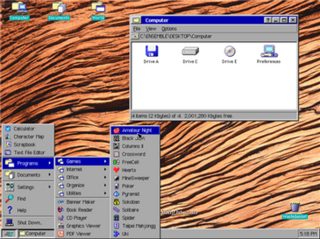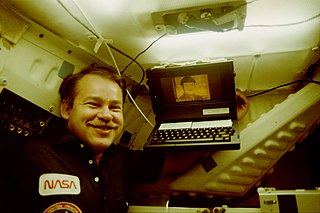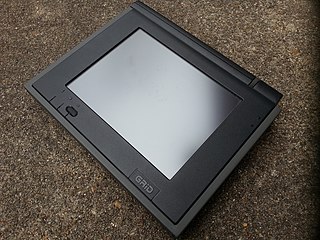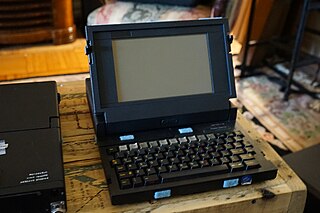
The RadioShack TRS-80 Color Computer, later marketed as the Tandy Color Computer and sometimes nicknamed the CoCo, is a line of home computers developed and sold by Tandy Corporation. Despite sharing a name with the earlier TRS-80, the Color Computer is a completely different, incompatible system and a radical departure in design and compatibility with its Motorola 6809E processor rather than the Zilog Z80 earlier models were built around.
Tandy Corporation was an American family-owned leather goods company based in Fort Worth, Texas, United States. Tandy Leather was founded in 1919 as a leather supply store. By the end of the 1950s, under the tutelage of then-CEO Charles Tandy, the company expanded into the hobby market, making leather moccasins and coin purses, making huge sales among Scouts, leading to a fast growth in sales.
Kaypro Corporation was an American home and personal computer manufacturer based out of San Diego in the 1980s. The company was founded by Non-Linear Systems (NLS) to compete with the popular Osborne 1 portable microcomputer. Kaypro produced a line of rugged, "luggable" CP/M-based computers sold with an extensive software bundle which supplanted its competitors and quickly became one of the top-selling personal computer lines of the early 1980s.

A laptop, laptop computer, or notebook computer is a small, portable personal computer (PC) with a screen and alphanumeric keyboard. Laptops typically have a clam shell form factor with the screen mounted on the inside of the upper lid and the keyboard on the inside of the lower lid, although 2-in-1 PCs with a detachable keyboard are often marketed as laptops or as having a laptop mode. Laptops are folded shut for transportation, and thus are suitable for mobile use. Its name comes from lap, as it was deemed practical to be placed on a person's lap when being used. Today, laptops are used in a variety of settings, such as at work, in education, for playing games, web browsing, for personal multimedia, and for general home computer use.

A portable computer is a computer designed to be easily moved from one place to another and included a display and keyboard together, with a single plug, much like later desktop computers called all-in-ones (AIO), that integrate the system's internal components into the same case as the display. The first commercially sold portable was the 50-pound (23 kg) IBM 5100, introduced 1975. The next major portables were Osborne's 24-pound (11 kg) CP/M-based Osborne 1 (1981) and Compaq's 28-pound (13 kg), advertised as 100% IBM PC compatible Compaq Portable (1983). These "luggable" computers still required a continuous connection to an external power source; this limitation was later overcome by the laptop. Laptops were followed by lighter models, so that in the 2000s mobile devices and by 2007 smartphones made the term almost meaningless. The 2010s introduced wearable computers such as smartwatches.

GEOS is a computer operating environment, graphical user interface (GUI), and suite of application software. Originally released as PC/GEOS, it runs on DOS-based, IBM PC compatible computers. Versions for some handheld platforms were also released and licensed to some companies.

The TRS-80 Model 100 is a portable computer introduced in 1983. It is one of the first notebook-style computers, featuring a keyboard and liquid crystal display, in a battery-powered package roughly the size and shape of a notepad or large book.

William Grant Moggridge, RDI was a British designer, author and educator who cofounded the design company IDEO and was director of the Cooper-Hewitt, National Design Museum in New York. He was a pioneer in adopting a human-centred approach in design, and championed interaction design as a mainstream design discipline. Among his achievements, he designed the first laptop computer, the GRiD Compass, was honoured for Lifetime Achievement from the National Design Awards, and given the Prince Philip Designers Prize. He was quoted as saying, "If there is a simple, easy principle that binds everything I have done together, it is my interest in people and their relationship to things."

The Gavilan SC was a laptop computer, and was the first ever to be marketed as a "laptop".

The Grid Compass is one of the first laptop computers.

The Sharp PC-5000 was a pioneering laptop computer, announced by Sharp Corporation of Japan in 1983. It employed a clamshell design in which the display closes over the keyboard, like the earlier GRiD Compass and contemporary Gavilan SC.

Pen computing refers to any computer user-interface using a pen or stylus and tablet, over input devices such as a keyboard or a mouse.

Following the introduction of the IBM Personal Computer, or IBM PC, many other personal computer architectures became extinct within just a few years. It led to a wave of IBM PC compatible systems being released.

The history of laptops describes the efforts, begun in the 1970s, to build small, portable personal computers that combine the components, inputs, outputs and capabilities of a desktop computer in a small chassis.

A personal computer (PC) is a multi-purpose microcomputer whose size, capabilities, and price make it feasible for individual use. Personal computers are intended to be operated directly by an end user, rather than by a computer expert or technician. Unlike large, costly minicomputers and mainframes, time-sharing by many people at the same time is not used with personal computers. Primarily in the late 1970s and 1980s, the term home computer was also used.

GRiDPad was a trademarked name for a series of pen computing tablets built by GRiD Systems Corporation.

GridCase is a line of rugged tablets and laptops by Grid Systems Corporation released as successor of GRiD Compass line.
The history of tablet computers and the associated special operating software is an example of pen computing technology, and thus the development of tablets has deep historical roots. The first patent for a system that recognized handwritten characters by analyzing the handwriting motion was granted in 1914. The first publicly demonstrated system using a tablet and handwriting recognition instead of a keyboard for working with a modern digital computer dates to 1956.
John Ellenby was a British businessman. He was the founder of Grid Systems Corporation, maker of the Grid Compass, one of the first commercially successful laptop computers. He also co-founded GeoVector, an early augmented reality company.
The Olivetti company, an Italian manufacturer of computers, tablets, smartphones, printers and other such business products as calculators and fax machines, was founded as a typewriters manufacturer by Camillo Olivetti in 1908 in the Turin commune of Ivrea, Italy. Olivetti was a pioneer in computer development, starting with the mainframe systems in the 1950s, and continuing into the 1990s with PC compatible laptops and desktops.


















